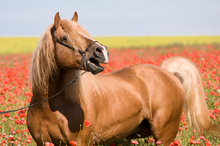Omega Fields’ Equine Nutrition Advisor, Kristina Hiney, Ph.D., has introduced a new article about key strategies in preventing laminitis in the equine. The article has been published in one of our Health E Letter issues, Omega Fields’ monthly, digital newsletter, and is also posted on the website.

Avoiding insulin resistance in horses
Horses which receive regular exercise seem to be fairly protected against laminitis, however, it is difficult to know whether the exercise aids in increasing insulin sensitivity or is simply protective against obesity.
In the article, Dr. Hiney draws on her extensive personal knowledge, experience with equine nutrition and physiology, and scientific studies to try to identify which individuals may be at risk, and other strategies that may be employed to reduce your horse’s risk.
Dr. Hiney states, “While the outward appearance of your horse may give you an indication to whether they are susceptible to laminitis, there may be more to it than just which horses are overweight. There certainly appears to be a genetic link to laminitis.”
If owners wish to try and avoid the development of insulin resistance, the diet the horse receives may be critical. There is evidence that diets which avoid high amounts of sugars and starches, and have a low glycemic response, resulting in less insulin release.
For horses which still need a significant amount of calories, diets which are fat and fiber based and properly formulated, rather than those which provide a higher glucose or insulinemic response, may prevent the development of insulin resistance.
Certainly just monitoring body condition in the horse may be the easiest way to avoid insulin resistance. Although, if you ask any horse owner if that is easy you may get a different response!
In addition, horses which receive regular exercise seem to be fairly protected against laminitis. However, it is difficult to know whether the exercise regimen aids in increasing insulin sensitivity, or is simply protective against obesity.
To read the complete laminitis article by Dr. Hiney that discusses the genetic role, obesity and insulin resistance, diet and lifestyle management.
Dr. Hiney has been working with Omega Fields since 2008 to expand our connection with our customers, giving them the nutrition and health information from scientific perspective they would like to know. Each month, Kris presents a feature article concerning horse health in Dr. Kris's Korner, her column in the Health-E-Letter.
About Omega Fields
Omega Fields® is recognized as a minority-owned business. Its mission is to offer the finest quality, most nutritious products at fair prices, and to provide outstanding customer service. Omega Fields wants its customers to have exceptional experiences with their products, staff, websites and retailers.
Omega Fields is the first manufacturer in the animal health industry to use human-grade, non-GMO stabilized ground flaxseed, rich in fiber and antioxidants, and containing the optimum ratio of the full spectrum of Omega 3, 6, and 9 Fatty Acids for equine, goat, canine, poultry and human nutrition.
The innovative use of flaxseed milled with a unique stabilization technology ensures long shelf life and superior quality for Omega Fields’ products.
